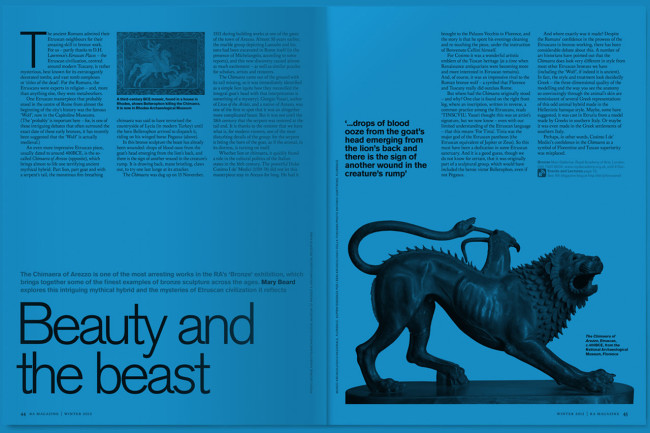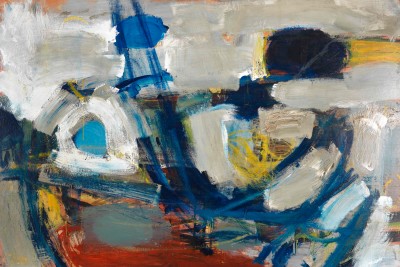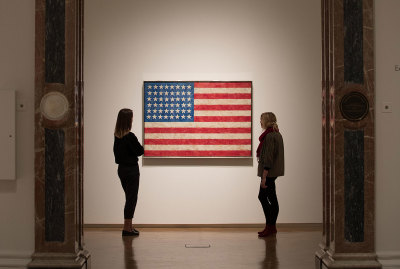“I taught Jack that” – Thomas Hart Benton and his student, Jackson Pollock
“I taught Jack that” – Thomas Hart Benton and his student, Jackson Pollock
By Debra N. Mancoff
Published 9 December 2016
Ahead of our America After the Fall exhibition, Debra N. Mancoff spotlights Hart Benton’s paintings of idealised rural life during the Great Depression – and his mentorship of an emerging young artist, Jackson Pollock.
-
From the Winter 2016 issue of RA Magazine, issued quarterly to Friends of the RA.
In 1973, upon hearing that the National Gallery of Australia had purchased Jackson Pollock’s magisterial painting Blue Poles (1952), the artist Thomas Hart Benton remarked to a friend: “I taught Jack that.”
Four decades earlier Pollock had studied with Benton at the Art Students League of New York. But the commonly held narrative of modern art decrees that Pollock the pupil had in fact rebelled against Benton the master, the explosive formal energy of Pollock’s Abstract Expressionism supplanting the naturalistic imagery of Benton’s brand of Regionalism, the Depression Era art movement that rooted American values in small town and rural life.
Although tinged with a sour irony, Benton’s claim of credit was, in fact, more than a brash boast. Throughout their years as teacher and student, and well beyond, the two men shared a close and significant alliance – as much an exchange as a competition – as both strove toward a singular goal: to portray the American experience in an art that was as dynamic as the volatile years between the wars. Following on from the RA’s exhibition of Abstract Expressionism, there is a chance to compare an early Pollock (Untitled, c.1938–41, below) to paintings by Benton including Haystack (1938, above) in the RA’s survey, America after the Fall: Painting in the 1930s. While Benton is well known in the US as a key player in this period, his work may be less familiar to visitors to the RA show. The exhibition reveals the diversity of styles that emerged during the Depression Era, through works by painters such as Grant Wood, Edward Hopper, Georgia O’Keeffe, Alice Neel and Philip Guston.
-
The two men shared a close and significant alliance – as much an exchange as a competition...
Debra N. Mancoff
-
Born in 1889, Benton came from a political family with deep roots in the Midwest. His father served four terms in the United States Congress, and from 1897 to 1905, the family spent as much time in Washington D.C. as they did in their hometown, Neosho, Missouri. Benton studied at the Corcoran Gallery of Art in Washington D.C., and after a brief stint in military school, he continued his education at the School of the Art Institute of Chicago. In 1909, he travelled to Paris where he took classes at the Académie Julian and responded with equal enthusiasm to the work of such avant-garde innovators as Robert Delaunay and Pablo Picasso as to that of such Old Masters as Rubens and Tintoretto.
Upon his return to the States in 1912, settling in New York City, he remained open to influence, claiming that he was “rocked by every boat that came along”. Although dedicated to figurative representation, Benton absorbed the lessons of Synchromism, an American abstract mode that heightened the energy of form through the brilliance of colour. During the First World War, Benton served in the US Navy, and at the war’s end, he defined the direction of his career with a multiple-panel mural cycle American Historical Epic (1919–28), an heroic account of the nation’s westward expansion.
Benton’s work came under the stylistic umbrella of American Scene Painting. Through the 1920s this loosely defined term encompassed both urban and rural subject matter, and, in part, in its naturalistic form and national content, marked a rejection of the European Modernist innovations as introduced to the American art world at the New York Armory Show in 1913. By the decade’s end, painters of small town and rural subjects were burnishing their interpretations with nostalgia, and their presentation of stalwart, hardworking Americans, while idealised, came to be seen as more authentic portraits of the American life and character than those representing big cities.
-

Thomas Hart Benton, Cotton Pickers, 1945.
Oil on canvas. 81.3 x 121.9 cm. The Art Institute of Chicago, Prior bequest of Alexander Stewart; Centennial Major Acquisitions Income and Wesley M. Dixon Jr. funds; Roger and J. Peter McCormick Endowments; prior acquisition of the George F. Harding Collection and Cyrus H. McCormick Fund; Quinn E. Delaney, American Art Sales Proceeds, Alyce and Edwin DeCosta and Walter E. Heller Foundation, and Goodman funds; prior bequest of Arthur Rublof; Estate of Walter Aitken; Ada Turnbull Hertle and Mary and Leigh Block Endowment funds; prior acquisition of Mr. and Mrs. Frank G. Logan Purchase Prize; Marian and Samuel Klasstorner and Laura T. Magnuson Acquisition funds; prior acquisition of Friends of American Art Collection; Wirt D. Walker Trust; Jay W. McGreevy Endowment; Cyrus Hall McCormick Fund; Samuel A. Marx Purchase Fund for Major Acquisitions; Maurice D. Galleher Endowment; Alfred and May Tiefenbronner Memorial, Dr. Julian Archie, Gladys N. Anderson, and Simeon B. Williams funds; Capital Campaign General Acquisitions Endowment, and Benjamin Argile Memorial Fund 2013.4 © Benton Testamentary Trusts/UMB Bank Trustee/VAGA, NY/DACS, London 2016.
-
The economic crises that brought on the Great Depression of the 1930s had partial origins in the agricultural hardships faced after the end of the First World War, when a surplus of production led to falling prices, and small farmers faced unexpected and unprecedented debt. The stock market crash of 1929, followed by severe dust storms, droughts and wind erosion that ravaged the prairies and Midwest farmland through the 1930s, made it seem as if the defining features of the American experience – abundance and opportunity – were slipping away. Images of life in rural areas and small towns, representing enduring values of hard work, thrift and resilience, came to be known as Regionalism, referring to the vast agricultural belt of the Midwest. Along with Grant Wood and John Steuart Curry, Benton gained acclaim as a Regionalist, painting a mythic America, an agrarian alternative to the harsh reality of straitened times.
It was a pair of important New York commissions that positioned Benton as a leader in this movement. America Today (1930–31), painted for the boardroom of the progressive New School for Social Research, depicted contemporary labour and leisure, and The Arts of Life in America (1932), painted for a reading room above what was then the home of the Whitney Museum, celebrated musical and craft traditions. Both ensembles sorted subjects by regional divisions, including the South, the Midwest, the West and New York, which represented the city. And both ensembles presented Benton’s distinctive treatment of the figure: muscular yet lithe, and twisting with rhythmic vigour in a pulsating composition, all painted in vibrant hues.
These features comprised Benton’s signature style, whether he worked on an epic or an intimate scale, as seen in Haystack, with its rolling landscape, vivid autumnal palette, and the lean and powerful figures absorbed in their work. As a popular and influential teacher at the Art Students League in New York, Benton disdained a set curriculum. He taught by example, later explaining, “I taught what I was trying to learn.” The League’s freewheeling atmosphere appealed to Pollock, who joined Benton’s studio in 1930. Born in Wyoming, Pollock had experienced an unsettled childhood, with his family on the move as his father searched for work in California. After repeated expulsions from schools in Los Angeles, Pollock followed an older brother to New York. Benton took him under his wing, finding him work, having him model, and welcoming him into his home.
Pollock’s earliest paintings echoed his teacher’s style and subject. But Benton moved from New York to Missouri in 1935, leaving Pollock adrift. He ended his formal training and found fresh inspiration in the complexity and expressive power of Mexican muralists, José Clemente Orozco and David Alfaro Siqueiros, both of whom had recently resided in New York. Pablo Picasso’s Guernica (1937), shown in New York in 1939, also made an indelible impression, as seen in Pollock’s Untitled. But while the disembodied limbs, the horse’s head and the fear-frozen face mirror Picasso’s imagery, the tumultuous composition, throbbing with rhythmic energy and glaring colour, reveal the deep impression of Benton’s example.
-

Jackson Pollock, Untitled, c.1938–41.
Oil on linen. 56.5 x 127.5 cm. The Art Institute of Chicago, Major Acquisitions Centennial Fund; estate of Florene May Schoenborn; through prior acquisitions of Mr. and Mrs. Carter H. Harrison, Marguerita S. Ritman, Mr. and Mrs. Bruce Borland, and Mary L. and Leigh B. Block, 1998.522 © The Pollock-Krasner Foundation ARS, NY and DACS, London 2017.
-
Looking back on Benton’s tutelage, Pollock claimed that, “He drove his kind of realism at me so hard I bounced right into non-objective painting.” But the real course of his development was more subtle and complex. Pollock boldly severed his imagery from conventional narrative content, but he initially seemed more reluctant to abandon solid, identifiable forms.
Mural (1943), commissioned by gallerist Peggy Guggenheim for the foyer of her Manhattan townhouse, marked the breakthrough in Pollock’s aesthetic and practice. The grand scale of the work – 8ft by 20ft – daunted him at first, and he alleged that he painted the dynamic tangle of slashing lines in the hectic efforts of a single evening, a claim that has come under scrutiny. No matter the myth-making, the work unleashed Pollock’s unexpected power in non-representational expression. Within a few years, he moved his canvas off the easel to attack the surface from all sides, dripping paint from a stiff brush with such gestural fluidity that the physical act of his painting became integral to the painting itself.
Benton held fast to the belief that the true spirit of American art was rooted in Regionalism. He hardened his convictions, fiercely confronting accusations of being anti-modern in publications and lectures, and, in works such as Cotton Pickers (1945, above), he continued to portray his elemental vision of a hardworking nation in his strong, sinuous figures, set against a rolling landscape painted in brilliant tones.
On the surface it would appear that Pollock the pupil had strayed far from his master’s example, but, as a fellow former student observed, “there was a rhythm and flow between them from the beginning to the end… a physical, gestural rhythm.” Whether representational or abstract in imagery, whether narrative or formal in content, the unique bond linking the work of Benton and Pollock plays out in the vigorous lines and vibrant colours that power their strikingly individual modes of painting. More than commanding oppositional poles in the saga of mid-20th-century American art, their working aesthetic – epic in scale and unbounded in energy – coursed as a multi-stranded yet intertwined through-line in the quest to create an American artistic identity in a rapidly changing world.
America after the Fall: Painting in the 1930s, The Sackler Wing, Royal Academy of Arts, London, 25 February – 4 June 2017
Abstract Expressionism, Main Galleries, Royal Academy of Arts, London, until 2 January 2017
-
-
Enjoyed this article?
Become a Friend to receive RA Magazine
As well as free entry to all of our exhibitions, Friends of the RA enjoy one of Britain’s most respected art magazines, delivered directly to your door. Why not join the club?

-






